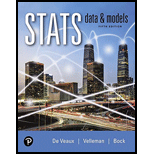
Concept explainers
a.
Find the expected number of birth in each season if there is no “seasonal effect” on births.
a.
Answer to Problem 1E
The expected number of birth in each season is 30 births per season.
Explanation of Solution
Given info:
The data represents the census of 120 students who are born in different season namely summer with 32, winter with 25, spring with 35 and fall with 28.
Calculation:
The general formula for expected count:
The expected count for each seasonal value can be obtained by the product of observed frequency with the percentage of each season:
Let observed value is the value of total students in the class which is 120 and percentage value is 0.25(25 percent) which does not change due to seasonal effect in the data.
Therefore, the remaining expected count for each season as follows:
| Season | Expected count |
| Winter | 30 |
| Summer | 30 |
| Spring | 30 |
| Fall | 30 |
Thus, the expected number of birth in each season is 30 births per season.
b.
Compute the
b.
Answer to Problem 1E
The value of
Explanation of Solution
Calculation:
The test statistic can be obtained as follows:
Thus the value of test statistic is 1.933.
c.
Compute degrees of freedom for the
c.
Answer to Problem 1E
The degree of freedom for the test statistic is 3.
Explanation of Solution
Calculation:
Degrees of freedom:
Here, there are four seasons.
The degrees of freedom is,
Thus, the degree of freedom for the test statistic is 3.
Want to see more full solutions like this?
Chapter 22 Solutions
Stats: Data and Models
- Business Discussarrow_forwardThe following data represent total ventilation measured in liters of air per minute per square meter of body area for two independent (and randomly chosen) samples. Analyze these data using the appropriate non-parametric hypothesis testarrow_forwardeach column represents before & after measurements on the same individual. Analyze with the appropriate non-parametric hypothesis test for a paired design.arrow_forward
- Should you be confident in applying your regression equation to estimate the heart rate of a python at 35°C? Why or why not?arrow_forwardGiven your fitted regression line, what would be the residual for snake #5 (10 C)?arrow_forwardCalculate the 95% confidence interval around your estimate of r using Fisher’s z-transformation. In your final answer, make sure to back-transform to the original units.arrow_forward
 MATLAB: An Introduction with ApplicationsStatisticsISBN:9781119256830Author:Amos GilatPublisher:John Wiley & Sons Inc
MATLAB: An Introduction with ApplicationsStatisticsISBN:9781119256830Author:Amos GilatPublisher:John Wiley & Sons Inc Probability and Statistics for Engineering and th...StatisticsISBN:9781305251809Author:Jay L. DevorePublisher:Cengage Learning
Probability and Statistics for Engineering and th...StatisticsISBN:9781305251809Author:Jay L. DevorePublisher:Cengage Learning Statistics for The Behavioral Sciences (MindTap C...StatisticsISBN:9781305504912Author:Frederick J Gravetter, Larry B. WallnauPublisher:Cengage Learning
Statistics for The Behavioral Sciences (MindTap C...StatisticsISBN:9781305504912Author:Frederick J Gravetter, Larry B. WallnauPublisher:Cengage Learning Elementary Statistics: Picturing the World (7th E...StatisticsISBN:9780134683416Author:Ron Larson, Betsy FarberPublisher:PEARSON
Elementary Statistics: Picturing the World (7th E...StatisticsISBN:9780134683416Author:Ron Larson, Betsy FarberPublisher:PEARSON The Basic Practice of StatisticsStatisticsISBN:9781319042578Author:David S. Moore, William I. Notz, Michael A. FlignerPublisher:W. H. Freeman
The Basic Practice of StatisticsStatisticsISBN:9781319042578Author:David S. Moore, William I. Notz, Michael A. FlignerPublisher:W. H. Freeman Introduction to the Practice of StatisticsStatisticsISBN:9781319013387Author:David S. Moore, George P. McCabe, Bruce A. CraigPublisher:W. H. Freeman
Introduction to the Practice of StatisticsStatisticsISBN:9781319013387Author:David S. Moore, George P. McCabe, Bruce A. CraigPublisher:W. H. Freeman





